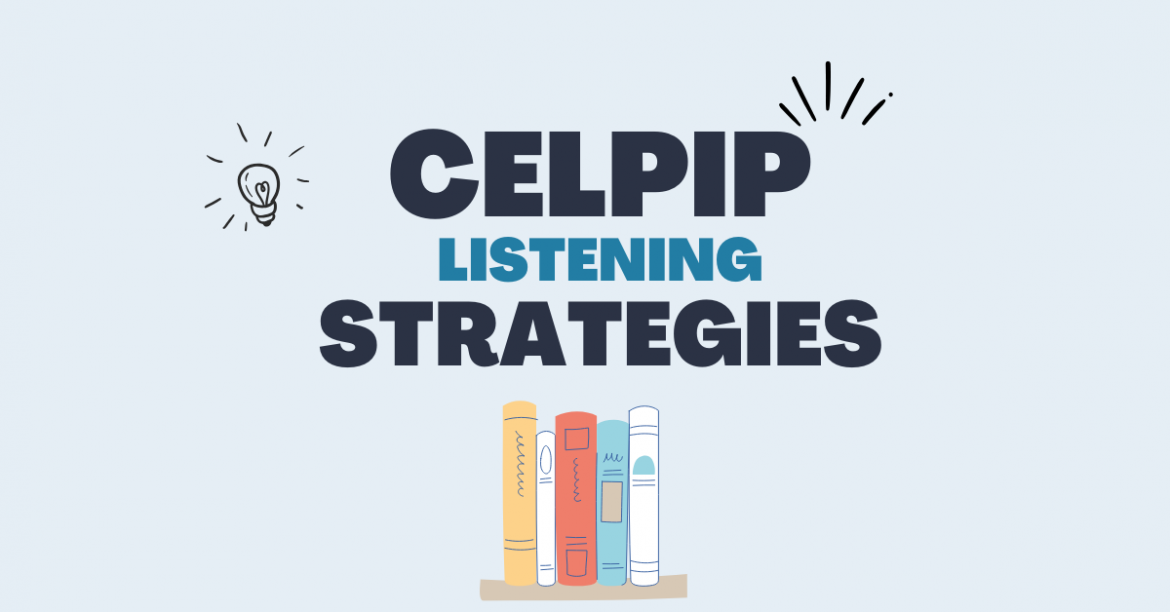CELPIP Listening Strategies:
- First and foremost, listen for Key Words and Synonyms
- Focus on important terms, especially those related to the question. That is to say, identify keywords or phrases that directly relate to the content, as they are essential for answering the questions accurately.
- Next, listen for Tone and Intent
- Pay attention to emotions and the speaker’s intentions. In other words, understanding tone can help clarify the speaker’s purpose and point of view, which is critical for proper comprehension.
- Then, take Quick Notes
- Write down key points, names, dates, and main ideas for reference. By doing so, you ensure that you don’t forget important details that may be needed later on, which helps you stay organized and focused.
- Additionally, watch out for Distractors
- Be alert for speakers correcting themselves or changing details mid-conversation. Consequently, you should be careful not to get distracted by irrelevant or changed information, as this may lead you to an incorrect answer.
- Moreover, use the Process of Elimination
- If you’re unsure of the right answer, start by eliminating incorrect options. This approach not only narrows down your choices but also boosts your confidence, thereby improving your chances of choosing the correct answer.
- Finally, don’t Panic if You Miss Something
- If you miss an answer, focus on the next question without dwelling on the missed one. By doing so, you maintain your concentration and keep up your pacing throughout the test, which is crucial for overall success.
Section-Wise CELPIP Listening Strategies:
1. Listening to Problem-Solving (Casual Conversations & Requests for Help)
- To begin with, identify the problem – What issue is being discussed? Recognizing the problem is crucial because it sets the context for the conversation, helping you understand the main topic.
- Afterward, note possible solutions – Listen for different ways to solve the problem. This allows you to understand the approaches being suggested and how they might resolve the issue at hand.
- In addition, understand relationships – Who is speaking, and what is their role? Knowing the relationship between speakers helps you interpret their responses more accurately, providing further insight into the conversation.
2. Listening to Daily Life Conversations
- First, follow the flow – Conversations in stores, banks, or workplaces often follow a predictable pattern. Recognizing this structure can help you anticipate what comes next, making it easier to follow the conversation.
- Next, listen for key details – Locations, prices, schedules, or instructions are important pieces of information. In particular, these details are often essential for answering the questions correctly and understanding the context.
- Furthermore, understand implied meaning – Sometimes, speakers don’t directly state answers. Therefore, interpreting the implied message is just as crucial as listening for explicit statements, which will help you grasp the full meaning.
3. Listening for Information (Recorded Announcements or News Reports)
- To begin with, focus on key details – Names, numbers, dates, locations, and instructions are vital for grasping the content. These pieces of information serve as the foundation for answering the questions.
- Then, pay attention to structure – Announcements usually begin with general information and then proceed to more specific details. This structure helps you organize your thoughts and anticipate what will follow.
- Additionally, watch out for comparisons – Discussions may compare two or more options. By keeping an ear out for comparisons, you can better understand the context and make more informed decisions about what the speaker is discussing.
4. Listening to a News Item
- To start, identify the main event – What happened, when, and where? Grasping the core event early on helps establish a foundation for understanding the full report, which is crucial for following along.
- Subsequently, listen for causes and effects – What led to the event, and what are its consequences? Understanding these elements will provide clarity about the significance of the event.
- Furthermore, pay attention to opinions – Expert or public viewpoints may be included. These perspectives offer additional context and help you understand the broader implications of the news item.
5. Listening to a Discussion (Debate or Group Conversations)
- First, recognize different opinions – Who agrees, who disagrees, and why? Identifying differing viewpoints allows you to understand the various perspectives being presented and to follow the flow of the conversation more effectively.
- Next, watch for transitions – Words like “but,” “also,” or “so” signal changes in ideas. These transitions help you stay on track and understand how one point leads to another.
- Moreover, understand reasoning – What evidence or examples do the speakers provide? By listening for these, you can evaluate the logic behind each argument and the reasoning supporting their opinions.
6. Listening to a Viewpoint (Monologue with Argument or Opinion)
- First, identify the speaker’s stance – Do they support or oppose something? This will give you a clear idea of the direction of the argument and the main purpose of the monologue.
- Then, note supporting arguments – What reasons or examples are provided? These arguments give weight to the speaker’s position and help you assess the validity of their viewpoint.
- Finally, listen for conclusions – The final part usually summarizes the main idea. Understanding the conclusion helps reinforce the overall message and provides clarity about the speaker’s position.
Practice Tips CELPIP Listening Strategies:
- To begin with, listen to English daily – Podcasts, news, and interviews improve your comprehension over time. Regular exposure to different accents and speaking styles is key to developing your listening skills.
- Furthermore, practice predicting – Guess what might be said next based on context. This will help you stay engaged and develop your anticipation skills, which will sharpen your listening abilities.
- Moreover, summarize what you hear – After listening to something, try explaining it in your own words. This reinforces your understanding and retention, and it helps you process information more deeply.
- Lastly, take full practice tests – This will help you become familiar with the pacing, question format, and overall structure of the test. Regular practice under timed conditions is essential for test preparedness.
The official website for the CELPIP test is:
- CELPIP – Paragon Testing Enterprises: www.celpip.ca
This website is the primary source for all information regarding the CELPIP test, including test registration, preparation materials, test format, scoring, and more. 1 It is essential to rely on this official website for accurate and up-to-date information about the CELPIP test.








